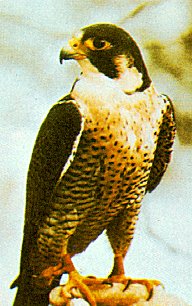Falco peregrinus
(Tunstall, 1771)
 Synonyms: Falco
peregrinus peregrinus - Falco peregrinus brevirostris
Menzbier, 1882, Falco barbarus germanicus Erlanger,
1903, Falco peregrinus riphaeus Buturlin, 1907; Falco
peregrinus calidus -Falco leucogenys C.L. Brehm, 1854, Falco
peregrinus caeruleiceps Stegmann, 1934; Falco peregrinus
brookei - Falco peregrinus caucasicus Kleinschmidt,
1907.
Synonyms: Falco
peregrinus peregrinus - Falco peregrinus brevirostris
Menzbier, 1882, Falco barbarus germanicus Erlanger,
1903, Falco peregrinus riphaeus Buturlin, 1907; Falco
peregrinus calidus -Falco leucogenys C.L. Brehm, 1854, Falco
peregrinus caeruleiceps Stegmann, 1934; Falco peregrinus
brookei - Falco peregrinus caucasicus Kleinschmidt,
1907.
Common names: Engl: Peregrine; Russ:
Sapsan; Turk: Gok dogan; Ukr: Sokil-sapsan,
Sapsan, Mandrivny sokil.
Order (Scientific): FALCONIFORMES.
Family (Scientific): FALCONIDAE.
Taxonomic descriptions: The Crimean
population of the South-European sub-species (F. p. brokei)
comprises 12-15 pairs. The tundra sub-species (F. p. calidus)
winters in small numbers (10-12 specimens). During migration and
wintering the nominative sub-species F. p. peregrinus is
the most common. About 60-80 birds migrate through, and 20-30
winter in, the region.
 IUCN Status:
IUCN Status:
World level: VU
Black Sea Regional level: EN
Subregion level: EN
Distribution:
Habitats type, Critical habitats, Limiting factors:
Breeding habitats are rocky precipices in the Crimean mountain
forests bordering open areas. Migratory birds occur throughout
the whole area: on the coast, in the inland water bodies, on the
steppe, in the villages and towns and their surroundings.
Biology: Sub-species F. p. calidus
and F. p. peregrinus migrate and winter in the region.
South-European sub-species (F. p. brokei) breeds,
migrate and partly winters. Breeding sites include niches and
ledges in the hardly accessible rocks. Breeding starts rather
early: display flights and copulation take place from the third
ten days of February till mid March (22.05 -16.03). Earliest
clutches are laid in the third ten days of March. Incubation
takes 30-33 days. Fledglings appear in the last ten days of
April. The brood size is 2-4. Part of the population leaves for
wintering grounds. Pairs and single birds move to the foot-hill
areas and big towns where they stay for the winter. Its diet
consists basically of small and middle sized birds like larks,
starlings, waders, doves and pigeons, crows, small ducks. Falco peregrinus preys
exclusively in air and takes its prey in flight.
Population trends: In the last 10-15 years a
slight increase in numbers has been recorded.
Threats: Human disturbance, hunting of
migratory birds, the illegal bird-trade and extraction of chicks,
various sicknesses of chicks (aspergillese, candidamicose).
Conservation measures taken: Falco
peregrinus is protected in the Karadag and Crimean
natural reservoirs.
Conservation measures proposed: A special
program for the protection of each breeding pair is necessary.
References:
- Ardamatzkaia T.B., Rudenko A.G. Birds//"Vestnik
Zoologii", "Invertebrates of the 'Chernomorski'
State Biosphere reserve /annotated lists of the
species." Kiev, 1996. - pp. 19-32.(in Russian).
- Beskaravainyi M.M. New data on the rare and poorly
studied species of the south-east Crimea //Vestnik
zoologii. - 1996. - #3. pp.71-72.(in Russian).
- Grinchenko A.B. New Data about Rare and Disappearing
birds of the Crimea //Rare birds of the Black Sea coastal
areas. -Kiev-Odessa: Lybid', 1991. - P. 78-90.(in
Russian).
- Zubarovsky V.M. Fauna of Ukraine. Vol.5, Birds. Issue 2.
Birds of prey. - Kiev, 1977. - 332 pp. (in Russian).
- Prokopenko S.P., Grinchenko A.B. Winterings of Peregrine
//Proc. of the Important Bird Areas in Ukraine Conference
- IBA Programme. Ukrainian Society for Bird Conservation.
- Kyiv, 1996.- P. 296-297. (in Russian).
- Red Data Book of Ukraine, 1994, p.338.
Compiled by: V.Kinda.
 Synonyms: Falco
peregrinus peregrinus - Falco peregrinus brevirostris
Menzbier, 1882, Falco barbarus germanicus Erlanger,
1903, Falco peregrinus riphaeus Buturlin, 1907; Falco
peregrinus calidus -Falco leucogenys C.L. Brehm, 1854, Falco
peregrinus caeruleiceps Stegmann, 1934; Falco peregrinus
brookei - Falco peregrinus caucasicus Kleinschmidt,
1907.
Synonyms: Falco
peregrinus peregrinus - Falco peregrinus brevirostris
Menzbier, 1882, Falco barbarus germanicus Erlanger,
1903, Falco peregrinus riphaeus Buturlin, 1907; Falco
peregrinus calidus -Falco leucogenys C.L. Brehm, 1854, Falco
peregrinus caeruleiceps Stegmann, 1934; Falco peregrinus
brookei - Falco peregrinus caucasicus Kleinschmidt,
1907. IUCN Status:
IUCN Status: